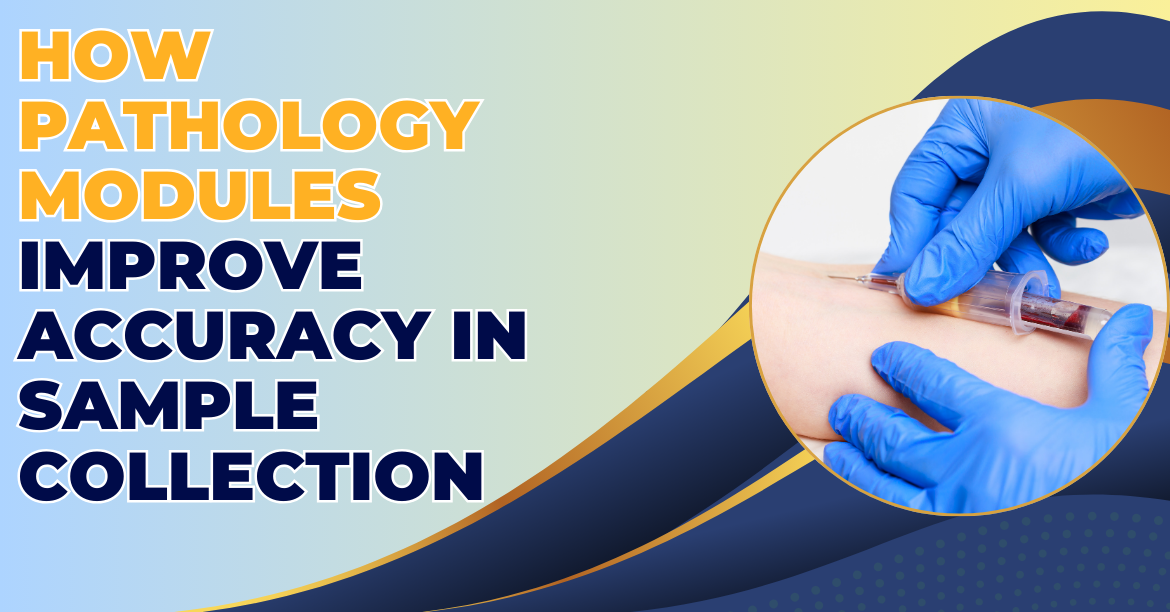


Accuracy and efficiency in diagnostic tests are essential in today's healthcare environment. In pathology labs, accurate sample collection is a crucial step in the diagnosis and tracking of illnesses. However, mistakes like inaccurate labeling, improper handling, or processing delays are common with old manual techniques. Here, the process has been completely transformed by pathology modules in hospital administration systems, which have improved sample collection accuracy and dependability.

Pathology modules are specialized software systems integrated within hospital management solutions. These modules streamline pathology lab operations, from sample collection and tracking to result analysis and reporting. Designed to minimize human error, they ensure that every step of the pathology process adheres to stringent quality standards.
Accuracy in sample collection is crucial because:
Errors in sample collection can lead to incorrect diagnoses, delaying appropriate treatments.
Incorrectly handled or mislabeled samples may jeopardize patient safety, leading to unnecessary procedures or medication.
Re-collecting samples due to errors increases costs and delays in delivering results.
One of the primary ways pathology modules improve accuracy is through barcode labeling. Each sample is assigned a unique barcode during collection. This barcode is scanned at every stage—from collection to testing to reporting—ensuring traceability and eliminating the risk of mix-ups.
Pathology modules integrate seamlessly with electronic medical records (EMRs). When a doctor orders a test, patient information is automatically linked to the sample. This eliminates manual data entry errors and ensures that the correct tests are performed for the right patient.
The software sends real-time alerts to lab staff and phlebotomists if discrepancies are detected. For instance, if a sample is not logged into the system within a specific timeframe, the module flags the issue, prompting immediate action.
Pathology modules enforce standardized collection protocols, guiding staff through each step of the process. For example, the software can provide instructions on the type of container required or the storage temperature for a specific test, ensuring consistency.
Every interaction with a sample is logged within the system. This chain of custody documentation ensures accountability and provides a complete audit trail in case of disputes or errors.
Monitoring samples from collection to reporting is known as sample tracking.
Quality checks: Confirms samples' integrity at several checkpoints.
Data analytics: Offers information on error patterns and potential areas for development.
Laboratory Instrument Integration: Reduces manual intervention by enabling direct communication between the module and diagnostic tools.
Workflows that can be tailored to a lab's or hospital's unique requirements.
Hospitals and diagnostic labs worldwide have reported significant improvements after implementing pathology modules. For instance, a study conducted in a multi-specialty hospital found that error rates in sample labeling dropped by 75% after adopting a pathology module. Additionally, turnaround times for test results improved by 30%, enhancing overall patient satisfaction.
Minimizes errors by using checks and automation.
Accelerates reporting and sample processing.
Cuts down on waste from mistakes and the need for additional testing.
Guarantees that rules and industry standards are followed.
The HealthaCard Pathology Module is well-known for its extensive reporting and tracking capabilities.
AcmePath: Combines workflows for sample collecting with advanced analytics.
LabTrack Pro: Prioritizes quality control and real-time monitoring.
Advanced features like AI-driven analytics and IoT-enabled devices for real-time sample monitoring are anticipated to be incorporated into pathology modules as technology advances. These developments will raise the bar for diagnostic testing by improving accuracy and efficiency even more.
Lab operations are being revolutionized by pathology modules, especially in the crucial area of sample collecting. These modules guarantee that patients obtain rapid and correct diagnosis by automating procedures, minimizing human error, and offering real-time tracking. Purchasing a pathology module is now necessary for healthcare practitioners who want to provide the best possible service.